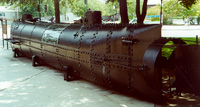Safety on Hunley coordinated by MUSC doc
by Chris WestPublic Relations
What do a crew of 50, the Confederate submarine Hunley, several search and rescue facilities and an emergency room physician have in common?
Safety.
 Richard
Guobaitis, M.D., is medical director for the project to raise
the Hunley. In addition to the strenuous demands on him as a physician
in the MUSC Trauma Center, he is also in charge of the safety of the 50-member
crew.
Richard
Guobaitis, M.D., is medical director for the project to raise
the Hunley. In addition to the strenuous demands on him as a physician
in the MUSC Trauma Center, he is also in charge of the safety of the 50-member
crew.
“Due to the nature of the project, there are very obvious safety issues at stake,” Guobaitis said. “We are talking about conditions related to diving such as embolism and the bends and with the cranes, cables and heavy machinery on the boats, we are looking to avoid and or treat situations ranging from crush injuries to amputations.”
Guobaitis was asked to establish protocols for any medical situations that may arise while the project is underway. Working with the Divers Alert Network, Sullivan’s Island Fire and Rescue, the U.S. Coast Guard, the Maritime Center, the Charleston Harbor Pilots and MUSC’s own MEDUCARE, Guobaitis collaborated and brainstormed with representatives from the facilities involved to put together a list of standard operating procedures.
 A
replica of the Confederate submarine, H. L. Hunley. The replica is displayed
at the entrance of the Charleston Museum.
A
replica of the Confederate submarine, H. L. Hunley. The replica is displayed
at the entrance of the Charleston Museum.
After a month on the job, the injuries sustained by crewmembers have been minor. “We have seen some minor lacerations in some of the oceaneering crew members and a few divers with sinus trouble and ear problems,” Guobaitis said. “Also some of the crew not from the Charleston area have not fully acclimated to the climate and some are suffering from allergies as a direct result.”
In a worst-case scenario injury situation, the Coast Guard has the capability to winch an injured crewmember or diver off of the boats or out of the water. They would then be transported to Fort Moultrie on Sullivan’s Island, where they could be met by either the Sullivan’s Island Fire and Rescue or a MEDUCARE transport vehicle.
While Fort Moultrie is the primary site for a rescue situation, much
of the treatment of small and minor injuries can be done right on the boats
themselves. “Many of the divers on board are certified emergency medical
technicians,” Guobaitis said. “They have access to equipment on the boats
that they would need to perform small injury treatment, such as first aid
kits and backboards.”
As an added precaution, the boats, rescue teams and Guobaitis
have a secured radio channel that allows constant radio contact. This facilitates
any action that may need be taken in the event of an injury and allows
Guobaitis to communicate and direct any on-board medical attention that
may need to be done.
Another aspect of medical treatment being extended to the project is care for the visiting families of the crewmembers. “At first, it was a factor I had not anticipated,” Guobaitis admitted. “But with no local physicians for the families that are visiting, we worked out a plan with the pediatric emergency room and our own facilities to see and treat the families as situations arise.”
The Hunley sank on Feb. 17, 1864 after a successful attack on the Union ship U.S.S. Housatonic. While the ship was sinking, the Hunley turned and headed back to Sullivan’s Island after having signaled Battery Marshall. The Hunley sank in 30 feet of water roughly three miles from its destination.
The Hunley lay lost until 1995, when bestselling author Clive Cussler and his crew found her. She lay buried under a meter of sediment with her bow pointed towards Sullivan’s Island.
The actual retrieval of the vessel is projected throughout July after seeing some small delays in the procedure. The project is also considering that hurricane season is a pending factor.
Working closely with Guobaitis in assuring safety measures are carried out is Larry Raney, M.D., also of the MUSC Trauma Center. Harry Peccorelli is the dive safety officer and one of the senior archaeologists involved. Dave Conlin is also involved as a senior archaeologist and Steve Wright is director of Oceaneering International, the company coordinating the raising. Robert S. Neyland, Ph.D. and branch head of the Naval Historical Center Underwater Archeology Branch, is the project manager for the Hunley Project.
Guobaitis said he was interested in seeing the project unfold and has
followed it as it has continued towards completion. “Seeing the project
go through with no major injuries means that all the hard work that has
been done by all, will finally pay off.”